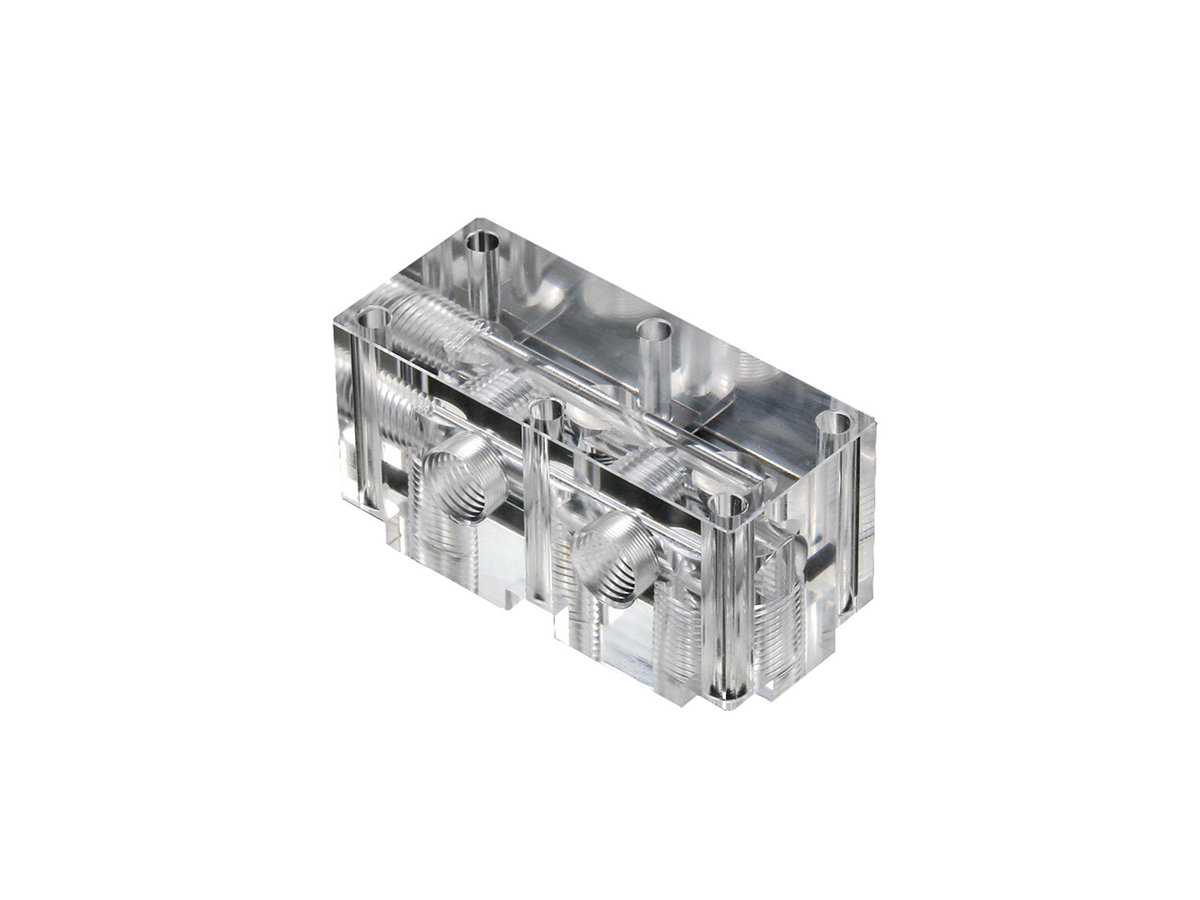Transparent Acrylic CNC Machining Service for Versatile, Chemical-Resistant Parts
Introduction
Transparent acrylic (PMMA) is widely used in industries that require clear visibility, excellent chemical resistance, and versatile machining capabilities. CNC machining ensures highly accurate dimensions (±0.01 mm) and superior surface finishes (Ra ≤0.8 µm), ideal for creating precise, aesthetically appealing components such as inspection windows, fluidic manifolds, and laboratory equipment covers. By leveraging advanced CNC machining services, manufacturers produce custom transparent acrylic components that meet stringent requirements in industries like medical devices, consumer products, and industrial equipment.
Customized CNC machining enables precise, optically clear, and chemically resistant acrylic parts designed specifically to enhance performance and durability in demanding environments.
Material Performance
Comparison Table
Material | Tensile Strength (MPa) | Hardness | Density (g/cm³) | Chemical Resistance (ASTM D543) | Typical Applications | Advantages |
|---|---|---|---|---|---|---|
70-80 | Shore D 85-95 | 1.19 | Excellent to acids, bases, oils | Inspection windows, protective covers | Exceptional optical clarity (>92% transparency), chemical stability | |
60-70 | Shore D 90-95 | 1.20 | Moderate to acids, excellent to oils | Protective shields, lenses | High impact strength (>900 J/m), transparency (~89%) | |
30-40 | Shore D 65-75 | 0.90 | Superior chemical resistance | Fluid handling parts | Outstanding chemical resistance, low density |
Selection Strategy
Material selection for transparent and chemical-resistant CNC machined parts requires careful consideration of application-specific requirements:
Acrylic (PMMA) offers superior optical transparency (>92%) and excellent chemical resistance (rated highly resistant per ASTM D543 to dilute acids, bases, and hydrocarbons), making it ideal for precise, visible parts like inspection windows and laboratory covers.
Polycarbonate (PC) provides high impact resistance (>900 J/m Izod impact strength) suitable for protective components. However, it exhibits moderate chemical resistance compared to acrylic, making it ideal for physically demanding environments with limited chemical exposure.
Polypropylene (PP) excels in chemical resistance to acids, alkalis, and organic solvents, as per ASTM D543, but is opaque and thus best used in internal fluid handling rather than transparent applications.
CNC Machining Process
Process Comparison
CNC Machining Technology | Dimensional Accuracy (mm) | Surface Roughness (Ra µm) | Typical Applications | Key Advantages |
|---|---|---|---|---|
±0.01 | 0.4-0.8 | Complex transparent components, intricate profiles | High detail, minimal internal stresses | |
±0.01 | 0.6-1.0 | Cylindrical clear components, optical lenses | Efficient production, precise cylindrical accuracy | |
±0.01 | 0.8-1.2 | Precision fluid channels, fastening holes | Precise hole placement, consistent accuracy | |
±0.005-0.01 | 0.2-0.8 | Highly detailed transparent parts, complex shapes | Exceptional precision, simultaneous machining from multiple angles |
Selection Strategy
Optimizing CNC machining processes ensures superior clarity, minimal distortion, and precise dimensions:
CNC Milling offers versatile shaping capabilities with precise feature detailing, maintaining surface roughness at Ra ≤0.8 µm, ideal for complex acrylic geometries such as manifolds and transparent covers.
CNC Turning is optimal for cylindrical parts requiring consistent optical quality and accuracy, achieving tolerances of ±0.01 mm and surface roughness ≤1.0 µm.
CNC Drilling ensures accurate and repeatable hole placements with dimensional tolerances of ±0.01 mm, suitable for precision channels and ports essential in fluid handling applications.
Multi-Axis CNC Machining provides precise machining (±0.005 mm accuracy) for intricate acrylic components, enabling superior surface finishes (Ra ≤0.8 µm) and minimal post-processing.
Surface Treatment
Treatment Comparison
Treatment Method | Transparency Improvement | Chemical Resistance | Max Operating Temp (°C) | Typical Applications | Key Features |
|---|---|---|---|---|---|
Optical clarity Ra ≤0.2 µm | Excellent | 85°C | Optical components, clear covers | High optical clarity (>95%), reduced surface irregularities | |
Good transparency, UV protection | Very good chemical resistance | 80°C | Outdoor transparent components | Increased durability, enhanced UV stability | |
Superior clarity Ra ≤0.1 µm | Moderate | 75°C | Highly visible acrylic parts | Smoothest finish available, exceptional aesthetics |
Selection Strategy
Surface treatments significantly enhance transparency, aesthetics, and durability:
Mechanical Polishing is preferred for acrylic components requiring the highest optical clarity (>95% transmission), achieving surface roughness of Ra ≤0.2 µm, suitable for inspection windows and optical instrumentation covers.
UV Coating improves chemical and UV resistance, providing durable protection for acrylic components used outdoors or under prolonged chemical exposure.
Vapor Polishing delivers exceptional surface finishes (Ra ≤0.1 µm) that maximize optical clarity and aesthetic appeal, ideal for display components and premium visible parts.
Quality Assurance Procedures
Quality assurance ensures precision and transparency in acrylic components:
CMM Inspection: Dimensional accuracy verification within ±0.01 mm using Coordinate Measuring Machines.
Surface Clarity Testing: Profilometer and optical inspection for transparency and surface roughness (Ra ≤0.8 µm).
Chemical Resistance Testing: ASTM D543 testing to validate chemical compatibility.
Impact and Tensile Testing: Mechanical testing per ASTM D638 and ISO standards to verify strength.
Visual Inspection: Detailed assessments to detect any surface defects or imperfections.
ISO 9001 Compliance: Comprehensive documentation and strict process adherence.
Industry Applications
Transparent inspection of windows and panels
Chemical-resistant laboratory manifolds
Optical lenses and covers
High-visibility protective components
Related FAQs:
Why choose CNC machining for transparent acrylic parts?
How does acrylic's chemical resistance benefit industrial applications?
What CNC machining processes are ideal for acrylic components?
Which surface treatments enhance acrylic part transparency and durability?
What quality measures ensure optimal performance of acrylic CNC machined parts?

